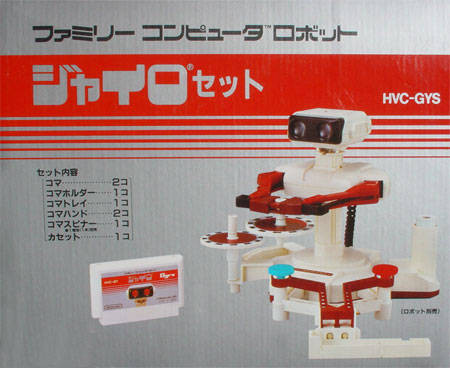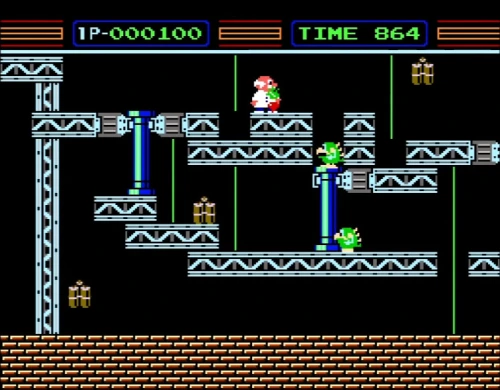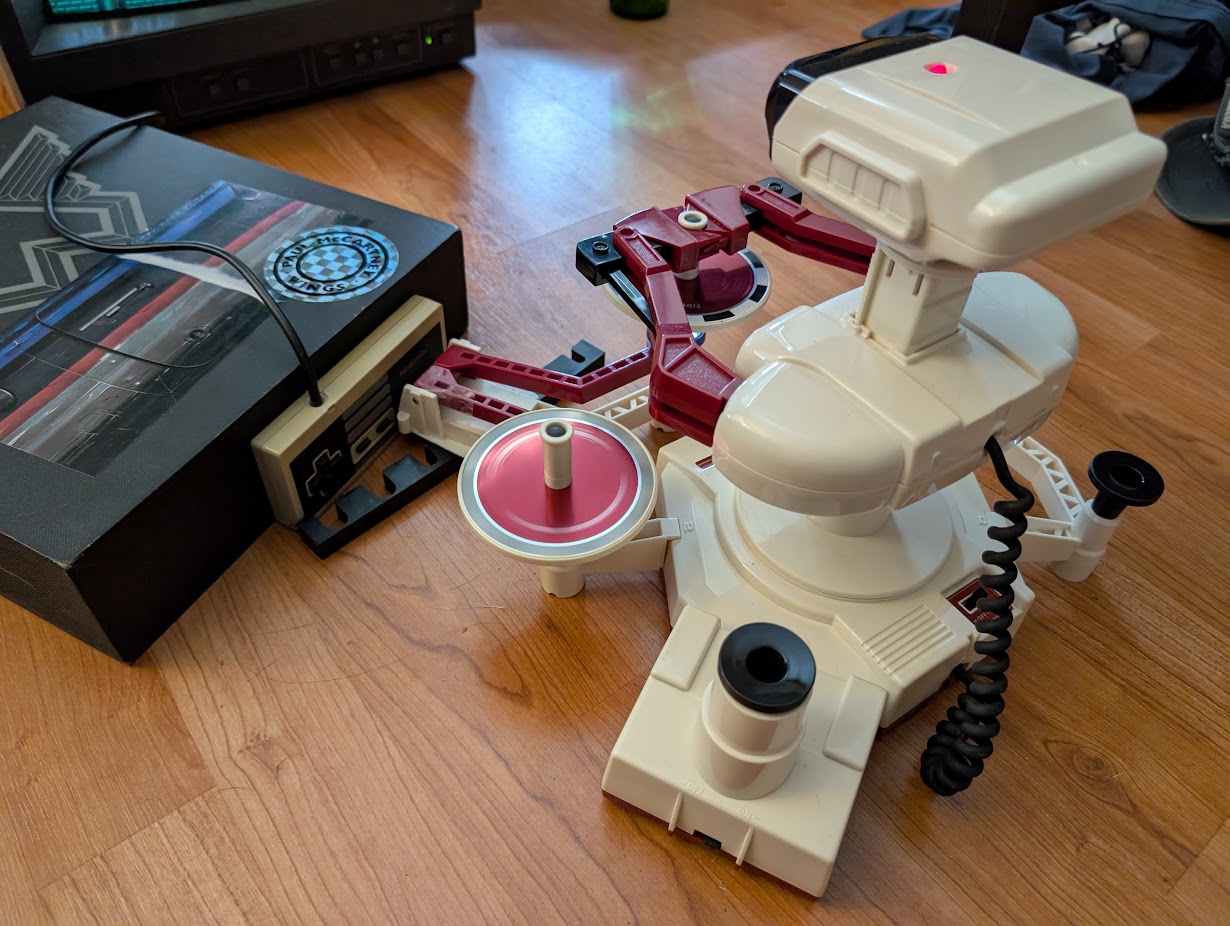GAME CLEAR No. 229 -- Robot Gyro
video games game clear robot series nintendo family computerRobot Gyro (1985, Family Computer)
English title: Gyromite
Developer: Nintendo
Publisher: Nintendo
Clear Version: Family Computer
Clear Platform: New Famicom
Clear Date: 6/2/25

| Why should I care? |
|---|
| Nintendo’s little Robot has an important place in North American video game history, and the rather contrived Gyro set is a fascinating if fussy accompaniment. |
おつかれさまです ロボットさん
The Robotic Operating Buddy, R.O.B., or simply “Family Computer Robot” as he is known in Japan is an adorable little device. As a Famicom/NES accessory, he takes on the role of an automated second player. His cute, round eyes, movable arms, and small stature make him look and feel like a buddy indeed — one anyone would be happy to have around, not just loser children with no friends or siblings. He launched with two games, and although more were promised, no more Robot-compatible software ever materialized. One of those games was Robot Gyro, or Gyromite as it is more pithily known in the English-speaking world (and as I’ll be referring to it henceforth). It’s quite frustrating at times, but its wholly unique “co-op” gameplay makes it a compelling bit of entertainment and highlights an important (if neglected) bit of Nintendo history.
It’s worth taking a moment to look at why R.O.B. even exists. In Japan in 1985, Nintendo’s Family Computer had been on the market for two years and was an unequivocal success with no signs of slowing down. Here in North America, the video game market — both coin-operated and home console games — began to tank in 1983 as a result of a variety of factors. Industry revenue was down by an order of magnitude, and some speculated the whole video game thing might have been a fad. Nevertheless, Nintendo of America was determined to bring Nintendo’s 8-bit console to market and have it succeed against the odds.
In the months preceding that launch, Nintendo had released the Family Computer Robot back in Japan. It was the fleshed-out product of a concept by the company’s legendary designer and idea-man Gunpei Yokoi. His idea was for a “photosensing video game control system” that would respond to flashes on a TV screen not unlike a light gun and would then perform corresponding actions. Nintendo of Japan turned this into their little Robot, and their Washingtonian colleagues saw an opportunity.
The Robot that they rebranded to R.O.B. fit perfectly with their goal to market the NES as something more than or at least different from a traditional Atari video game console that North Americans were familiar with. Commercials such as this one highlighted R.O.B. and the Zapper (packaged together in the NES Deluxe Set) rather than Mario, who got a sub-second cameo. Indeed, the very name “Nintendo Entertainment System” was meant to play into this notion that the console wasn’t just another video game device.
Their plan was a success, and a study commissioned by Nintendo itself found that R.O.B. was a primary motivator for a small plurality of children asking for an NES in late 1985. It’s a small sample size at just 200, but it’s not nothing. Personally, I feel pretty confident that Super Mario Bros. would have caught on no problem and made the NES a success on its own, but there is certainly evidence to suggest that R.O.B. got the console into a substantial number of homes early on. With that barrier to entry lowered, selling Mario cartridges would definitely not be a problem.
His role in getting NES units into North American homes makes his unceremonious abandonment a bit tragic. As aforementioned, no software was released for R.O.B. post-launch. This isn’t a great surprise, I suppose, inasmuch as R.O.B. is only capable of picking things up and putting them down in a fixed radius around his body. It’s just hard not to feel some affection for the little guy.
Despite my yearning for more, I will say that Gyromite may well have been the perfect use case for his limited abilities anyway. The game puts you in control of Professor Hector, whose must traverse 40 stages of his labyrinthine laboratory to collect and extinguish the lit dynamite scattered about. Why is it there? Who knows? Who cares?
Prof. Hector also serves as your proxy for controlling R.O.B., who also exists in his universe. R.O.B. controls the various gates throughout the lab, so you/Hector must order him (by pressing Start and then a button) to perform the necessary operations to open and close them as needed. The Robot loyally maintains his steely gaze on the TV awaiting your instruction, which is transmitted to him by way of flashes on your cathode-ray tube television set.

The process of opening and closing gates involves R.O.B. picking up the spinning tops (gyros) mounted to his right (this setup is pictured on the box art above) and using them to press the blue and red pedestals in front of him (opening the gates of matching color). These serve as levers that press buttons on the second player’s controller cradled in front of him. In many cases, R.O.B. can simply maintain a hold on the gyro and keep it balanced on the button while you move Hector through and then remove it and/or move it to the other button as needed. The poor boy has just one set of arms, though, and sometimes he has to raise both gates at once. That’s where the gyros come in. By placing one in the spinner to his left, R.O.B. can then place it on a button and allow the miracle of physics to keep the top pressing the button down without falling off, freeing him to use the other gyro to press the other button.
This is a very cute little routine, but R.O.B. moves rather agonizingly slow, which is a problem for a few reasons. First of all, all stages are timed. Run out of time before collecting all the dynamite in a stage, and you’ll have to start all over. The timer is pretty generous, so this usually isn’t a problem, but Hector must also contend with little green bird-like enemies called Smicks. One touch of these guys will kill him and require a full stage restart as well. There are little veggies scattered about that Hector can use to distract them, which is a help, but it still means that one missed or bad command to R.O.B. can spell disaster.
It all just seems a bit silly and cumbersome when the game could be played quite easily with a human second player. Still, I was determined to finish the entire game with my newly acquired Family Computer Robot. Despite R.O.B.’s glacial movements, lack of failsafe features against bad movements, grinding gears, and general fussiness, I beat every damn level of Games A and B on the cartridge, and I had a good bit of fun!
Game A (the one described above) is just a swell bit of puzzle platforming, frankly. It’s not super involved, but it does take a bit of brainwork to figure out how to navigate each stage and open and close the appropriate gates. Racing against the clock creates some adrenaline-inducing urgency, and what R.O.B. lacks in snappiness Hector makes up for with simple, responsive controls. Also, despite the rather considerable contrivance that is the physical gyro setup, it’s fun to watch those little tops go! They remain upright for an astonishing amount of time (if you don’t accidentally knock them over with a clumsy R.O.B. command).
Game B takes a different approach, having Hector sleepwalk through precarious stages. The principle remains the same, R.O.B. must manipulate gates throughout these stages to allow the somnambulant professor to arrive to the end of the stage safely. I like this idea conceptually, but it’s plagued a bit by some nasty surprise jumps and traps of that nature. This is particularly problematic because Game B grants you just three lives to complete all of its 25 stages, in contrast to Game A, which gives you just five for the purpose of your high score but allows you to select any of its 40 stages at will. For this reason I used some help from a guide for Game B so I could at least see each full stage at once for planning purposes.
Despite my grievances, I really rather enjoyed Gyromite, and I’m glad to have played it with a functioning Family Computer Robot. To the average video game enjoyer, there probably isn’t enough there to justify the price of acquiring a fully Gyromite setup, but I love this sort of shit. I may never bust this game out again, but I love having the little Robot in its Famicom colorway as a decorative piece. Who knows? Maybe I’ll come up with some stupid homebrew for him someday.
As a bonus, here’s some footage of the Robot completing a full stage of Game A. Also a photo of some jury rigging I did to hold my controller in place since it didn’t fit the cradle that was designed for an original Famicom controller.
